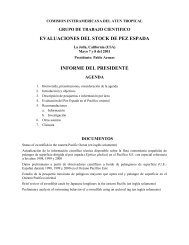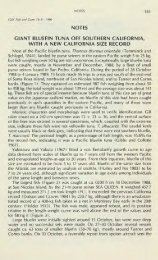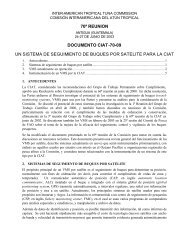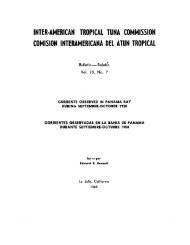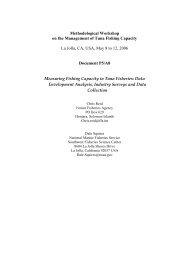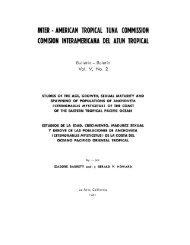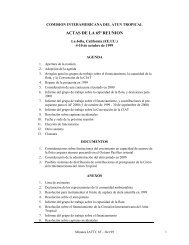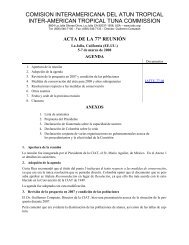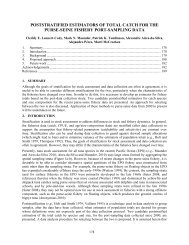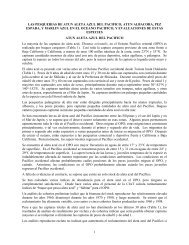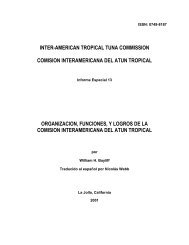Informe Anual de la Comisión Interamericana del Atún Tropical, 19
Informe Anual de la Comisión Interamericana del Atún Tropical, 19
Informe Anual de la Comisión Interamericana del Atún Tropical, 19
Create successful ePaper yourself
Turn your PDF publications into a flip-book with our unique Google optimized e-Paper software.
38 TUNA COMMISSION<br />
William Perrin (U.S. NMFS), Carolyn Heath (University of California at Santa Cruz), rng.<br />
Ornar Vidal (Instituto Tecnológico <strong>de</strong> Estudios Superiores <strong>de</strong> Monterrey, Se<strong>de</strong> Guayrnas)<br />
Program:<br />
Introduction to marine mammals: general characteristics of cetaceans, pinnipeds, and<br />
sirenians.<br />
Laboratory techniques for the study of marine mammals.<br />
Dissection of cetaceans and pinnipeds.<br />
Collection and preservation of specimens.<br />
Reproductive biology: anatomy, physiology, and analyses.<br />
Age estimation: preparation of pinniped and dolphin teeth and whale ear plugs.<br />
Interpretation and analyses.<br />
Field techniques D)r marine mammals.<br />
Handling of strandings.<br />
Handling of inci<strong>de</strong>ntal takes.<br />
Uses of photoi<strong>de</strong>ntification.<br />
Tagging studies: techniques to study movements, behavior, social structure, and<br />
reproduction.<br />
Telemetry systems: radio, sonar, and satellite.<br />
Behavioral observations at sea or in rookeries.<br />
Photogrammetry and acoustics.<br />
Conservation and management of marine mammals.<br />
Fisheries interactions.<br />
International research and management organizations.<br />
COURSE 2: Estimation of Abundance of Marine Mammals<br />
Location: Industria Lobera y Pesquera <strong>de</strong>l Estado (lLPE), Cabo Polonio, Uruguay<br />
Dates: November 23-December 5, <strong>19</strong>87<br />
Coordinators: Drs. Martin Hall (IATTC) and Isaías Ximénez (lLPE)<br />
lnstructors: Lic. Alejandro Anganuzzi, Dr. Stephen Buck<strong>la</strong>nd, and Dr. Martin Hall (lATTC), Lic. Ana<br />
Parma (University ofWashington), Dr. Anne York (U.S. NMFS)<br />
Program:<br />
Problems for the conservation and management of marine mammals.<br />
Interaction with man: direct fisheries and inci<strong>de</strong>ntal take.<br />
Mo<strong>de</strong>ls used to manage marine mammals: maximum sustainable yield and variations,<br />
assumptions, <strong>de</strong>ficiencies, and results of their use.<br />
Monitoring marine mammals as an alternative approach to mo<strong>de</strong>lling for management and<br />
conservation.<br />
What is estimation? Bias, precision, absolute and re<strong>la</strong>tive abundance, and trends.<br />
Sampling <strong>de</strong>sign for marine mammal popu<strong>la</strong>tions.<br />
Estimation ofvariances: analytical and non-parametric methods.<br />
Methods used to estimate abundance.<br />
Line and strip transects: mo<strong>de</strong>ls and assumptions.<br />
Surveys: shore, aerial, and vessel. Design and comparison.<br />
Counts: practical problems and limitations.<br />
Mark-recapture studies: assumptions, mo<strong>de</strong>ls (closed and open popu<strong>la</strong>tions).<br />
Catch-per-unit-of-effort methods: Leslie, DeLury, and use of tagging or<br />
photoi<strong>de</strong>ntification as ways of "catching."<br />
Change-in-ratio methods: Kelker, Chapman, and Paulik-Robson.



